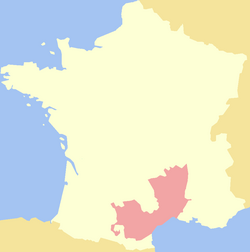Languedoc, France
| Languedoc | |||
|---|---|---|---|
|
|||
 |
|||
| Country | France | ||
| Time zone | CET | ||
Languedoc (/ˌlɒŋɡəˈdɒk/ ; French: [lɑ̃ɡdɔk] ; Occitan: Lengadòc [ˌleŋɡɔˈðɔ]) is a former province of France. Its territory is now contained in the modern-day region of Occitanie in the south of France. Its capital city was Toulouse. It had an area of approximately 27,376 square kilometers (10,570 square miles).
The traditional provinces of the kingdom of France were not formally defined. A province was simply a territory of common traditions and customs, but it had no political organization. Today, when people refer to the old provinces of France, they are referring to the gouvernements as they existed in 1789, before the French Revolution. Gouvernements were military regions established by the Crown in the middle of the 16th century; their territories closely matched those of the traditional provinces. However, in some cases, small provinces were merged with a large one into a single gouvernement, so gouvernements are not exactly the same as the traditional provinces.
Historically, the region was called the County of Toulouse, a county independent from the kings of France. The County of Toulouse was made up of what would later be called Languedoc, but it also included the province of Quercy (now the département of Lot and the northern half of the département of Tarn-et-Garonne) and the province of Rouergue (now the département of Aveyron), both to the northwest of Languedoc. At some times it included the province of Agenais (now the eastern half of the département of Lot-et-Garonne) to the west of Languedoc, the province of Gévaudan (now département of Lozère), the province of Velay (now the central and eastern part of the département of Haute-Loire), the southern part of the province of Vivarais (now the southern part of the département of Ardèche), and even all the northern half of Provence. After the French conquest the entire county was dismantled, the central part of it being now called Languedoc.
...
Wikipedia


